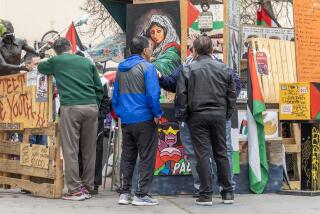Protesters’ First March Is a Pleasant Disappointment
- Share via
At 2:10 p.m. Sunday, after months of anticipation and dread, that dark and unpredictable force called “the protesters” finally made its debut on the streets of Los Angeles.
A few thousand strong, they spilled down the steps of Pershing Square, onto the sun-drenched intersection of 5th and Hill streets, past platoons of grim-faced police officers. What happened in the next two hours, as they marched through downtown toward Staples Center, was something less than the catastrophe of stone-throwing and vandalism many had feared and predicted.
It was instead a jumble of angry voices and confusion, a day of baby-faced anarchists shouting expletives at the police and of shoppers locked in stores by panicked merchants. It was, in other words, just another strange day in a city famous for strangeness.
Judging from the rhetoric of the speakers at Pershing Square, one might have expected more trouble.
“All of these people are dripping with the blood of the poor!” said Pam Africa, “minister of confrontation” for the Philadelphia group MOVE, as she launched into an attack on the police. “These cops are like pit bulls! When someone says ‘Sic ‘em!’ they do it. They kill children!”
Sunday’s rally and march were meant to draw attention to the case of Mumia Abu-Jamal, the man on death row for killing a Philadelphia police officer. Most people seemed content to voice their disgust with the death penalty by listening to the speeches and by shouting slogans during what amounted to a long walk on a hot day.
With so little happening inside Staples Center, packs of correspondents with cameras and notebooks scanned the faces in the crowd, looking for the troublemakers in the mix--and the day’s Big Story.
*
Marching through the canyon of old brownstone office buildings was a young woman who covered her face with a black bandanna. Was she one of the infamous anarchists the media have been telling us about, hiding from the police? Actually, no.
Meliza Banales, 22, said she was merely trying “to make a statement that I’m being silenced by this government.” Banales is a graduate student from Compton who teaches creative writing in prison. “I don’t agree with the way the raza is treated.”
When Banales and the thousands of other demonstrators turned the corner on 5th and reached Broadway, they were greeted by the cacophony of dozens of steel shutters closing along the shopping strip.
The merchants, who for months have been scared by warnings of glass-shattering mobs, were also bracing for the worst. The only victims ended up being the unfortunate folks who had picked the wrong time for a shopping trip.
As the marchers trod past one closet-sized store featuring fluffy white dresses for baptisms and First Communions, the shutters rose to reveal two families who had been trapped inside. They stepped out, pushing strollers and looking confused. One man picked up a young girl who was crying inconsolably.
Benitio Tlapa, a pint-sized shoeshine man, had been trying to drum up business on Broadway when the mass of protesters appeared. Rather than flee, he decided to join in, picking up the short stool his customers sit on. With his shoeshine box hanging from a strap over his shoulder, he worked his way near the front and stood next to a young woman who was beating on a drum. He opened and closed the tiny door of his shoe box to the same beat. Tap-tap, tap-tap.
“No a la muerte!” he shouted in Spanish. No to death!
Did he know who the march was for, who the dreadlocked man named Mumia was in the big signs people carried?
“No,” Tlapa said flatly. “But he’s a human being. They shouldn’t kill him.”
At the corner of 7th and Broadway there was, at last, a hint of trouble. A demonstrator with a shaved head and a goatee ran at a line of helmeted police officers that was blocking part of the intersection. The officers merely pushed the man back and he bounced off them, like someone dancing in a mosh pit.
Two blocks away, another marcher wasn’t having such a good time. The cherub-faced young man had the slogan “Smash fascism” taped to the back of his shirt, but he wasn’t doing anything to advance that particular cause. Instead, he was vomiting in the street.
Someone guided him to a shady spot on the sidewalk and suggested he sit down for a bit. What’s wrong? he was asked. “I think I drank too much tap water,” he answered.
Finally, the march arrived at the parking lot across the street from Staples Center, the officially designated protest zone. A few skinny young men clad entirely in black, their faces covered with bandannas and ski masks, scaled the tall security fence that seals off the arena.
One placed a flag at the top, an upside-down Stars and Stripes with a circled “A” drawn in the middle.
The anarchists had finally reached Staples Center.
A few feet away, on the other side of the fence, a few police officers barely noticed. One even gave a weak smile.
More to Read
Sign up for Essential California
The most important California stories and recommendations in your inbox every morning.
You may occasionally receive promotional content from the Los Angeles Times.














